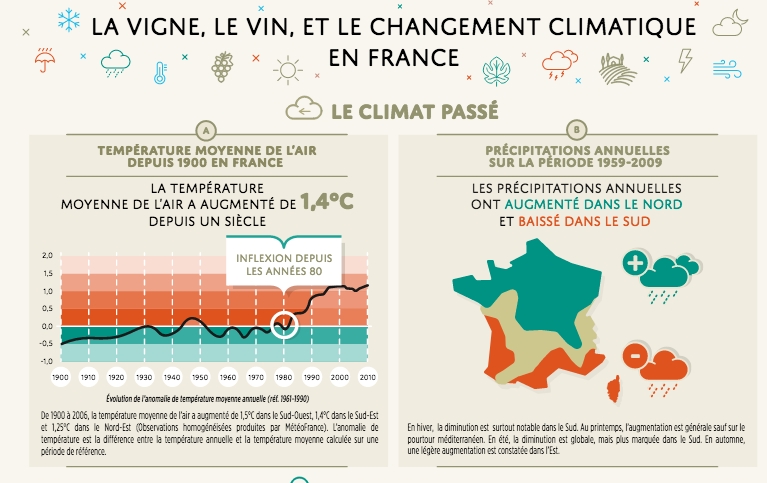Climate plays a major role in shaping the aromatic profile of wine. Every variation in the weather affects the vine, the grapes and the final aromas. Understanding this interaction allows us to better appreciate the diversity of wines and the specific characteristics of each terroir.
Wine climate: a decisive factor for aromas
Wine climate refers to all weather conditions during the vine cycle. Temperature, rainfall and sunshine have a direct influence on grape ripening. A warm climate accelerates ripening, favors sugar and reduces acidity. A cool climate slows ripening and preserves acidity, which modifies the intensity of wine aromas.
In warmer regions, wines are rounder, more powerful, with ripe, fruity notes. In cooler climates, wines are lighter, more acidic, with floral, citrus or herbal aromas.
Hot climates: concentration and intensity
In warm climates such asAustralia, South Africa and parts of southern France, vines receive a lot of sunshine. This produces grapes rich in sugar, often harvested earlier. These wines develop aromas of candied fruit, plums, figs and even dark chocolate for the reds.
High exposure also favors spicy, even smoky aromas. However, the lack of acidity can unbalance certain cuvées if the winemaker has not mastered the vinification process.
Cool climates: finesse and complexity
In cooler regions such as Burgundy, the Loire and Germany, the wine climate slows grape development. Slow ripening means better retention of primary aromas. The result is elegant wines with floral, lemony or mineral notes.
Wine aromas develop slowly. The cool climate allows grape varieties such as Pinot Noir and Riesling to express themselves with subtlety. These wines often have good ageing potential.
The vintage effect: one year's weather changes everything
Each vintage reflects the year's weather patterns. A rainy season can dilute flavors. A drought can block ripening or over-concentrate aromas. The annual wine climate therefore influences the style of wine produced, even in the same plot.
A warm vintage often develops more alcoholic, supple and expressive wines. A cool vintage produces more nervous wines, sometimes austere at first, but often with strong aromatic potential.
Winegrowing and weather: how winegrowers adapt
Winegrowers have to adjust their methods according to the weather. In humid regions, they watch out for disease. In hot regions, they protect the vines from water stress. Winemaking and weather form a duo that the grower must manage to preserve grape quality.
Some change the harvest date or choose rootstocks suited to the soil and climate. The aim is to harvest healthy, well-balanced grapes that express their full aroma.
Wine aromas: the impact of day/night temperature differences
Temperature differences between day and night have a strong influence on wine aromas. A wide temperature range favors balance between sugar and acidity. The grape develops a wider range of aromas.
In high-altitude vineyards or those close to the ocean, this variation is frequent. Wines produced under these conditions have clean, often brighter aromas, with a fresh, lively mouthfeel.
Continental, oceanic and Mediterranean climates: what are the differences?
Three main types of wine climate structure European viticulture:
- Continental climate: cold winters, hot summers, little rain. It produces concentrated, powerful wines, sometimes capricious depending on the year.
- Oceanic climate: influence of wind and rain, moderate temperatures. Produces supple, well-balanced wines, often lighter in weight.
- Mediterranean climate: long, dry summers, mild winters. It favors the production of rich, sunny wines with intense aromas of ripe fruit.
Microclimates: when details change everything
Each plot has its own specific microclimate. Altitude, slope, sun exposure or morning mists create significant variations. These microclimates add a unique complexity to wine aromas.
A vineyard at the top of a windy hill will not produce the same grapes as one nestled in a humid valley. This diversity contributes to the richness of aromatic profiles within the same appellation.

The influence of climate on aromatic grape varieties
Highly aromatic grape varieties such as Gewurztraminer, Sauvignon Blanc or Muscat react strongly to the wine climate. Their palette changes according to temperature.
In a warm climate, Gewurztraminer develops exotic notes, while in a cool climate, it expresses subtle floral aromas. Sauvignon Blanc, very sensitive to climatic conditions, can vary from lime to white peach, depending on the region.
Winegrowing and weather: the challenges of climate change
Climate change is having a major impact on winemaking and weather. Grapes are harvested earlier. Wines are more alcoholic. Aromas are evolving. Some regions have to adapt their grape varieties. Others are discovering a new viticultural aptitude.
In traditionally cooler areas, warmer temperatures enable better ripening. Elsewhere, it poses problems. Preserving wine aromas is becoming a strategic issue. Winegrowers are experimenting with new practices to adapt.
If you enjoyed this article, you might also like to read "The art of wine in literature and cinema: a timeless passion"!





